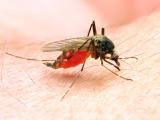May 22, 2012
Study: H1N1 vaccine generates antibodies to range of flu strains
The pandemic 2009 H1N1 (pH1N1) vaccine produced antibodies in people not only against pH1N1, but also against other influenza virus strains, including H5N1 avian flu and H3N2 seasonal flu, according to a study yesterday from Proceedings of the National Academy of Sciences. The antibodies were reactive to the relatively stable stem region of the influenza virus hemagglutinin (HA), as opposed to the HA head, which can vary widely among strains. The findings bring researchers a small step closer to developing a vaccine that protects against a host of flu viruses, a group led by Emory University scientists said. They analyzed B cell antibody responses in 24 adults after pH1N1 vaccination and found that 25 of 28 antibodies identified protected against multiple flu strains and seemed to result from B-cell memory from previous exposure to other flu strains. "Our new finding is a key step in the development of a vaccine that can produce high levels of antibodies that protect against multiple flu strains," lead author Rafi Ahmed, PhD, said in an Emory news release. The authors concluded in the study, however, "The challenge now is to improve upon this result and design influenza vaccines that can elicit these broadly cross-reactive antibodies at sufficiently high levels" to provide broad protection. The same investigators reported in January 2011 that pH1N1 infection produces cross-protective antibodies similar to those from vaccination, and a Canadian group earlier this month reached similar conclusions about the pH1N1 vaccine.
May 21 Proc Natl Acad Sci abstract
May 21 Emory news release
Jan 14, 2011, CIDRAP News story on earlier Emory study
May 8 Canadian study abstract
New inhaled flu antiviral shown similar to Relenza in kids
A Japanese study in Pediatrics found the new neuraminidase inhibitor (NI) laninamivir octanoate performed similarly to zanamivir (Relenza) in children age 15 or younger who had influenza, but laninamivir may be more convenient, especially for older children. In Japan, oseltamivir (Tamiflu) is not recommended for children older than 10, because the health ministry suspects it could be linked to abnormal behavior. Until September 2010, zanamivir was the only NI available to Japanese youngsters. Both laninamivir and zanamivir are inhaled drugs, but laninamivir is given once on the day the patient is diagnosed as having influenza, and zanamivir is taken twice a day for 5 days. The study was conducted at a hospital between Jan 2011 and May 2011 and included 112 children with confirmed influenza who were randomized to receive one of the drugs. Most of the patients with flu had the 2009 H1N1 virus. The drugs were given at home, and parents recorded symptoms before and after administration. The median time to fever resolution was similar for both drugs: 36 hours for laninamivir, and 37 hours for zanamivir. No differences were seen regarding asthma symptoms, pneumonia, gastrointestinal symptoms, or abnormal behaviors. Six younger children had difficulty inhaling laninamivir. The group wrote that some of the patients in both groups didn't inhale deeply enough to receive the complete medication dose, and that the consequences of inadequate dosing would be greater for laninamivir, since it is just given in just one dose. They noted that more studies are needed to determine how incomplete laninamivir inhalation affects fever resolution.
May 21 Pediatrics abstract
Review pinpoints fake and substandard malaria drug problems
A review of malaria drug surveys from Southeast Asia and sub-Saharan Africa found that from 20% to 42% of the drugs were fake, posing a threat to populations most at risk for the disease, according to a study published today in The Lancet Infectious Diseases. The researchers, led by scientists at the National Institutes of Health's Fogarty International Center, reviewed published literature and unpublished data from 1999 to Feb 20, 2012, about the chemical analysis and packaging of antimalarial drugs in those two regions. Surveys from seven Southeast Asian countries included data on 1,437 samples of malaria drugs. One-third failed the chemical analysis, half weren't correctly packaged, and 36% were fakes. Review of data from 21 African nations on 2,634 drug samples found a third failed chemical analysis and 20% were fakes. Investigators wrote that antimalarial drugs are widely distributed and self-prescribed in the two regions, which lack systems to monitor drug quality and clinician and patient knowledge about the drugs. Also, regulatory oversight is lax in many countries. Joel Breman, MD, DTPH, coauthor of the study and senior scientist at the Fogarty Center, said in a Fogarty press release, "These findings are a wakeup call demanding a series of interventions to better define and eliminate both criminal production and poor manufacturing of antimalarial drugs."
June Lancet Infect Dis abstract
May 21 Fogarty Center press release
Studies identify key players in severe malaria
Research teams from three separate countries today reported new findings about the host-parasite interaction in malaria, including how parasites bind to cells in the brain to cause cerebral malaria, the deadliest form of the disease. The three studies, in Proceedings of the National Academy of Sciences (PNAS), focus on a malaria parasite protein called Plasmodium falciparum erythrocyte membrane protein 1 (PfEMP1), of which a single type was previously known to mediate placental malaria during pregnancy. The group of proteins that includes PfEMP1 helps red blood cells that are infected by the parasites bind to blood vessel walls, which helps them evade detection. A group from the University of Denmark looked at different levels of PfEMP1 transcripts in blood from children hospitalized in Tanzania. They found that genes encoding two PfEMP1 subtypes, cassettes 8 and 13, were linked to severe malaria and were recognized by naturally acquired immunity. In another study, researchers from the University of Edinburgh found that the same two cassettes mediated the binding of infected blood cells to blood vessels in the brain, which they wrote might provide a new target for drugs, tests, or vaccines. The third group, from Seattle Biomedical Research Institute (SBRI), reported that domain cassette 8 mediates binding activity for brain blood vessel cells, and they found a possible explanation for how the protein variants that mediate cerebral malaria persist. Alexandra Rowe, DPhil, of the University of Edinburgh, said in an SBRI press release, "The coming together of these three studies, which all identify the same key players in severe malaria, is an important milestone." She added that researchers are eager to start applying the new findings toward new malaria solutions.
May 22 PNAS University of Denmark abstract
May 22 PNAS University of Edinburgh abstract
May 22 PNAS SBRI abstract
May 21 SBRI press release


















